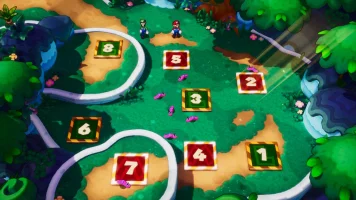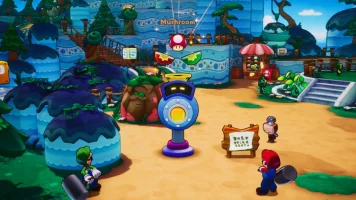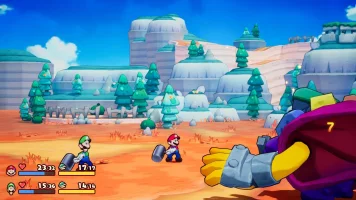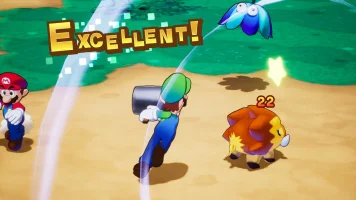Official Review
The review examines Brothership's core gameplay elements, story progression, and technical performance across different Nintendo Switch modes. Players will discover how the new island-hopping adventure maintains series traditions while introducing fresh mechanics. We'll also analyze the game's visual presentation, combat system, and overall appeal to both newcomers and longtime fans of the Mario & Luigi franchise.
Gameplay Mechanics and Combat System
The combat system in Brothership stands as the game's strongest feature, building upon the series' traditional turn-based formula while introducing innovative mechanics. Each battle showcases the brothers' signature moves, with jump attacks and hammer strikes requiring precise button timing to maximize damage output.
Turn-based battles and Bros. Attacks
Combat feels remarkably fluid as Mario and Luigi execute their moves with carefully timed button presses. The Bros. Attacks return as flashy special moves that deal significant damage when executed perfectly. These cinematic attacks, while visually impressive, sometimes blur together in terms of utility, as many late-game moves simply deal area damage without distinct tactical advantages.New Battle Plug system
The game's most significant innovation comes in the form of the Battle Plug system, which introduces a layer of strategic depth roughly ten hours into the adventure. These equipable modifiers transform combat by allowing players to:- Enhance attacks with elemental effects
- Apply status effects to multiple enemies simultaneously
- Modify defensive capabilities during crucial moments
- Create powerful combinations through plug synergies
Luigi Logic puzzles
The new Luigi Logic mechanic serves multiple purposes throughout the adventure. During exploration, it manifests as moments where Luigi has sudden realizations about solving environmental puzzles. These instances often involve transforming the brothers into various forms, such as a UFO or a rolling ball, to overcome obstacles. While these puzzles tend to lean toward the simpler side, Luigi Logic truly excels during boss battles, where it introduces unique situational attacks and strategic opportunities.The battle animations deserve special mention, successfully translating the charm of classic sprite work into modern 3D presentations. Performance remains consistently smooth during combat sequences, ensuring that the precise timing required for attacks isn't compromised by technical issues. This attention to detail helps maintain the series' reputation for engaging, action-oriented turn-based combat.
Story and World Design
The fractured world of Concordia serves as the backdrop for this maritime adventure, where a mysterious force has scattered the once-united land into drifting islands. At the heart of this tale lies a creative premise: Mario and Luigi must pilot Shipshape Island, a unique vessel that's equal parts ship and landmass, to restore connections between isolated communities.
Island-hopping adventure
The brothers' journey through Concordia unfolds as they navigate from island to island, each destination offering its own contained narrative. Players traverse diverse landscapes including:- Lush tropical rainforests teeming with wildlife
- Urban metropolises inspired by modern architecture
- Volcanic regions split between magma and ice
- Ancient ruins plagued by mischievous birds
- Tourist destinations centered around peculiar landmarks
Concordia's unique setting
The world of Concordia distinguishes itself through its electrical motif, where power connections serve as both literal and metaphorical bonds between communities. The Great Lighthouse stands as a testament to this design philosophy, with its dazzling display of power transmission creating ropes of lightning that stretch elegantly across the sea. This visual spectacle reinforces the game's themes of unity and interconnection.Character designs and humor
The inhabitants of Concordia showcase Nintendo's creative character design, though with mixed results. Connie, the well-intentioned Wattanist, combines botanical expertise with electrical engineering in a charming package. The game's humor leans heavily on wordplay and puns – some landing better than others. Billdit the hammer crafter and Groovemaster Dyode, a fusion of Elvis Presley and George Clinton, exemplify the game's commitment to quirky characterization.The writing maintains a consistently whimsical tone, though it occasionally stumbles with repetitive jokes. Snoutlet's running gag about definitely not being a pig and the main villain's tendency to forget names showcase both the strengths and limitations of the game's humor. While the power outlet-shaped residents might not resonate with everyone, they represent a welcome return to original character designs after previous entries' reliance on familiar faces.
The world-building particularly shines in moments of connection, such as when the brothers successfully link islands to the power grid. These instances are accompanied by vibrant visual celebrations that make each accomplishment feel meaningful, even if the broader narrative sometimes treads familiar ground.
Technical Performance and Visuals
Brothership represents a significant visual evolution for the Mario & Luigi series, marking its first fully 3D entry with a vibrant cel-shaded art style. The transition brings both impressive achievements and notable technical challenges that impact the overall experience.
Frame rate issues
Performance issues emerge as one of Brothership's most significant technical hurdles. The game struggles to maintain stable frame rates, particularly during sequences with multiple enemies or elaborate particle effects. These performance dips become especially noticeable in later stages, where even the island navigation screen suffers from significant slowdown due to the abundance of cubic sparkle effects. While not game-breaking, these technical limitations can impact the timing-sensitive combat sequences that are central to the experience.Handheld vs. docked mode
The performance disparity between playing modes presents an interesting dilemma for players. In handheld mode, the game maintains a more consistent frame rate with only occasional stutters during particularly busy scenes. However, docked mode reveals more pronounced technical issues, making it less than ideal for extended play sessions. This difference is particularly noticeable when:- Navigating water-heavy environments
- Engaging in multi-enemy battles
- Executing Bros. Attacks with extensive visual effects
- Exploring areas with complex environmental elements
Art style and animations
Despite its technical shortcomings, Brothership's artistic direction showcases remarkable attention to detail. The game features:- Expressive character animations that capture the brothers' personalities
- Rich, saturated colors that bring Concordia's varied environments to life
- Detailed facial expressions that convey emotions effectively
- Smooth transition effects between different combat states
The world of Concordia benefits from thoughtful artistic choices, with environments featuring distinct visual themes that range from tropical paradises to industrial zones. Character designs show particular creativity in their electrical-themed elements, though some texturing choices – particularly in environmental objects – reveal the technical constraints of the platform.
The visual presentation maintains the series' signature charm while pushing it in new directions. Secondary animations, such as the movement of Luigi's hat or the rippling effects of water, add subtle but meaningful depth to the presentation. While the performance issues can't be ignored, they don't completely overshadow the artistic achievements that make Brothership a visually distinctive entry in the franchise.
Pros and Cons
After extensive playtime with Mario & Luigi: Brothership, clear strengths and weaknesses emerge that shape the overall experience. Let's examine what works and what falls short in this latest installment.
Engaging combat system
The battle system emerges as Brothership's crowning achievement, delivering a satisfying blend of strategy and timing-based gameplay. The Battle Plug system introduces meaningful tactical choices that keep combat fresh throughout the adventure. Key combat strengths include:- Precise timing mechanics for attacks and dodges
- Strategic plug combinations for varied approaches
- Excellent enemy variety with unique attack patterns
- Smooth animation transitions during battle sequences
- Balanced difficulty progression
Nostalgic elements for fans
Brothership successfully captures the essence of classic Mario & Luigi adventures while introducing modern refinements. The cel-shaded art style pays homage to the series' sprite-based origins, particularly evident in character animations and battle sequences. The return of signature moves and familiar faces will resonate with longtime fans, though newcomers may miss some of the subtle callbacks to previous entries.Pacing and dialog issues
Despite its strong foundation, Brothership stumbles in maintaining consistent momentum. The game's 34-hour campaign often feels padded, particularly in its final third. Dialog sequences frequently interrupt the flow of exploration, with excessive tutorials and explanations that can test player patience. The Luigi Logic system, while conceptually interesting, sometimes reduces puzzle-solving to watching automated solutions rather than engaging with them directly.The writing quality fluctuates throughout the adventure. While some character interactions sparkle with wit, others rely too heavily on repetitive jokes and obvious wordplay. The villain's running gag of misremembering names, for instance, wears thin after multiple encounters.
Comparison to previous entries
Brothership both evolves and deviates from its predecessors in notable ways:| Aspect | Previous Games | Brothership |
|---|---|---|
| Combat Depth | Focused on timing | Enhanced with Battle Plugs |
| Luigi's Role | Equal protagonist | More automated helper |
| World Design | Linear progression | Open island structure |
| Puzzle Design | Cooperative challenges | Simplified solutions |
| Animation Style | Sprite-based | Modern 3D cel-shaded |
The game's approach to Luigi's character represents a particular point of contention. While previous entries treated him as an equal partner in both exploration and combat, Brothership often reduces him to an automated assistant during puzzle sequences. This change fundamentally alters the series' signature cooperative gameplay dynamic.
The Battle Plug system stands as the most significant innovation, offering more strategic options than any previous entry. However, this mechanical depth comes at the cost of some of the series' characteristic charm and cooperative puzzle-solving elements.
Performance issues, particularly in docked mode, impact the overall experience more noticeably than in previous entries. While the combat remains largely unaffected, exploration and cutscenes can suffer from noticeable frame rate dips that weren't present in earlier installments.
The game's extended length proves both a blessing and a curse. While it offers substantial content for the price point, the final stretch feels artificially extended through repetitive encounters and backtracking. This padding contrasts sharply with the tighter pacing of classic entries in the series.
Conclusion
Mario & Luigi: Brothership stands as a bold step forward for the beloved RPG series, successfully modernizing classic gameplay elements while introducing meaningful innovations. The Battle Plug system breathes fresh life into the combat mechanics, offering strategic depth that series veterans will appreciate. Though technical limitations and pacing issues create occasional stumbling blocks, the game's charming presentation and varied island environments demonstrate Nintendo's commitment to evolving the franchise beyond its sprite-based roots.
The final verdict places Brothership as a worthy addition to the Mario & Luigi series, despite not quite reaching the heights of its most celebrated predecessors. Players who can look past the performance hiccups will discover a substantial adventure filled with clever combat encounters and memorable character moments. While some design choices may divide longtime fans, particularly regarding Luigi's reduced puzzle-solving role, the game's core mechanics and creative world-building provide enough entertainment value to justify the journey through Concordia's scattered isles.






